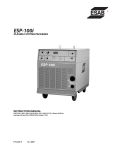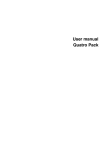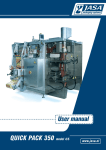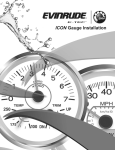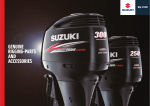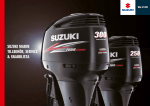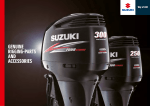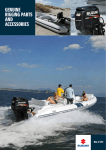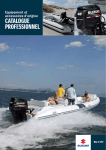Download Suzuki 86W41 User's Manual
Transcript
Part Number: 990C0-86B40/86W41 Applications: Synchronizer Suzuki Marine Boats NOTE: Mounts in standard 3 3/8" hole. Weight: Description: Contents Ref. Part Number 1 HRS Installation Time: 1 lbs Description QTY 1. 990C0-86B40/86W41 2. BC0146 Synchronizer 1 Mounting Bracket 1 3. Mounting Hardware 1 1 RIA FA PORT SLOW AS UNC RP. CO VILLE, CT. MADE IN U .S.A. SYNC 7500 -90 -25 A STBD SLOW 1 3 2 If so equipped YELLOW/ RED YELLOW BLACK GRAY Tools Required Ref. Tools Description 1. 3/8" Nut Driver 2. Suzuki Terminal Kit Important Please read this manual and follow its instructions carefully. To emphasize special information, the symbol and the words WARNING, CAUTION and NOTE have special meanings. Pay special attention to the messages highlighted by these signal words: NOTE: Indicates special information to make maintenance easier or instructions clear. NOTE IS0207B ECR5609 8/2005 09900-28701 Indicates potential hazard that could result in death or injury. Indicates potential hazard that could result in vehicle damage. Disconnect battery during installation. Tighten nuts on backclamp only slightly more than you can tighten with your fingers. Six inch-pounds of torque is sufficient. Over tightening may result in damage to the instrument and may void your warranty. Gasket cement or other adhesive is not required to secure tubing to fittings. Description The dual engine synchronizer is designed to indicate engine synchronization extremely accurately when the speeds of the two engines are compared to each other. Engine synchronization may be difficult at idle speeds. For proper operation, both engines must be of the same type, have the same number of cylinders, and have similar ignitions. Malfunctioning ignition systems or high speed "point bounce" will result in inability to sync properly. Installation 1. Location: The synchronizer should be located at least 18" from a magnetic compass. Some interference (erratic operation) may be noticed on the synchronizer during radio transmissions. This will neither damage nor degrade it's performance. 2. Be certain to use stranded, insulated wire not lighter than 18AWG that is approved for marine use. It is recommended that insulated wire terminals, preferably ring type, be used on all connections to the gauge, except the light which requires a 1/4" female blade terminal. 3. Cut a 3-3/8" dia hole in the dash and mount the gauge with backclamp supplied. 4. Using a small screwdriver, SLIGHTLY depress and turn the selector switch on the back of the synchronizer to the correct position to match the engine application. (See label on the side of the synchronizer.) Depressing the switch too hard may cause damage to gauge! Be sure the selector switch has locked into the detent at the correct position by slightly rotating the switch back and forth with the screwdriver. 5. If this gauge kit has been supplied with a three prong connector, slide the connector over the three instrument studs. Be sure the gray, yellow, and black bullets are connected to the gray, yellow, and black wires of the main engine harness. the yellow wire of the main engine harness. 8. Connect yellow/red extension lead stud connector to the PORT signal (SIG) post terminal of the synchronizer. 9. Connect the black extension lead stud connector to the negative (-) post of the synchronizer and plug the bullet end into the black wire of the main engine harness. 10. Connect the GREEN/ORANGE extension lead to the blade terminal adjacent to the twist-out light assembly to the positive “+” side of the instrument lighting circuit and the bullet end to the boat lighting circuit. No separate ground is required for the lighting. Reconnect the battery. 11. Calibration: This gauge has been calibrated at the factory, and should never need adjustment. However, If you are experiencing problems refer to the Calibration section at the end of this manual. 12. NOTE: To change the light bulb, twist tan socket assembly one-eighth turn counterclockwise until it pops out. Bulb pulls straight out of socket assembly. It is a GE No.194 instrument lamp. Mounting Hardware Kit A x 6 B x 6 C x 2 6. Connect the gray extension lead stud connector to the positive (+) post of the synchronizer and plug the bullet end into the gray wire of the main engine harness. 7. Connect the yellow extension lead stud connector to the STARBOARD signal (SIG) post terminal of the synchronizer and plug the bullet into A A C B A B Harness Dia gram HN0397 revA ecr 4452 03/2004 Yellow/Red Yellow/Red Sync Port Green/Orange Green/Orange Green/Orange Lights Sync Stbd Yellow Black Yellow Black Black Gray Gray Gray Ground +14V Heat shrink tubing HN0418 rev A ecr 5609 8/05 Yellow Yellow Trouble Shooting Yellow Trouble Inspection Diagnosis Action Gauge Sticks A. Backclamp may be too tight. 1. Slightly loosen nuts holding backclamp. Check operation. 1. If gauge works and is not loose in panel, continue using gauge. 2. If gauge continues to stick, replace gauge. Gauge Inoperative A. Is power applied to gauge? 1. Switch the instrument power supply switch on and off. As power is supplied the pointer should jump slightly. 1. Check wires to check they were installed on the correct terminals and power is actually supplied to gauge. 2 If pointer jumps (indicating power supplied), check for signal from engine. If signal exists, replace tachometer. Trouble shooting continued next page. Trouble Shooting Trouble Inspection Diagnosis Action Gauge is Pegged A. The synchronizer reads hi or low. 1. The synchronizer is in the wrong switch position. 1. Check calibration. (See the calibration section at end of this manual.) 2. The synchronizer is not calibrated. Gauge is Erratic Calibration A. Inspect the connection between the wire and the ring connector. 1. Fix connection. 1. Check for insulation that may have been pushed into connection. B. Check for excessive electrical noise caused by an electrical appliance set to close to the gauge. i.e. a magnetic compass, a radio transmission. 1. Check wires by connecting one wire at a time to the synchronizer directly from the battery or the signal source on the engine. 1. Relocate offensive appliance. Please refer to installation instructions. Start the engines and (after an appropriate warm-up period and with shifts in neutral) increase their speeds to the boat's normal cruising RPM. (Both tachometers must be properly calibrated.) Set the coarse adjustment switch to the proper position described on it's label. Remove the stop-plug (at the 8-o'clock position on the rear of the case for most) and insert a 5/16" allen wrench into the "fine adjustment" trumpet, rotating it CW or CCW as necessary to center the synchronizer.




